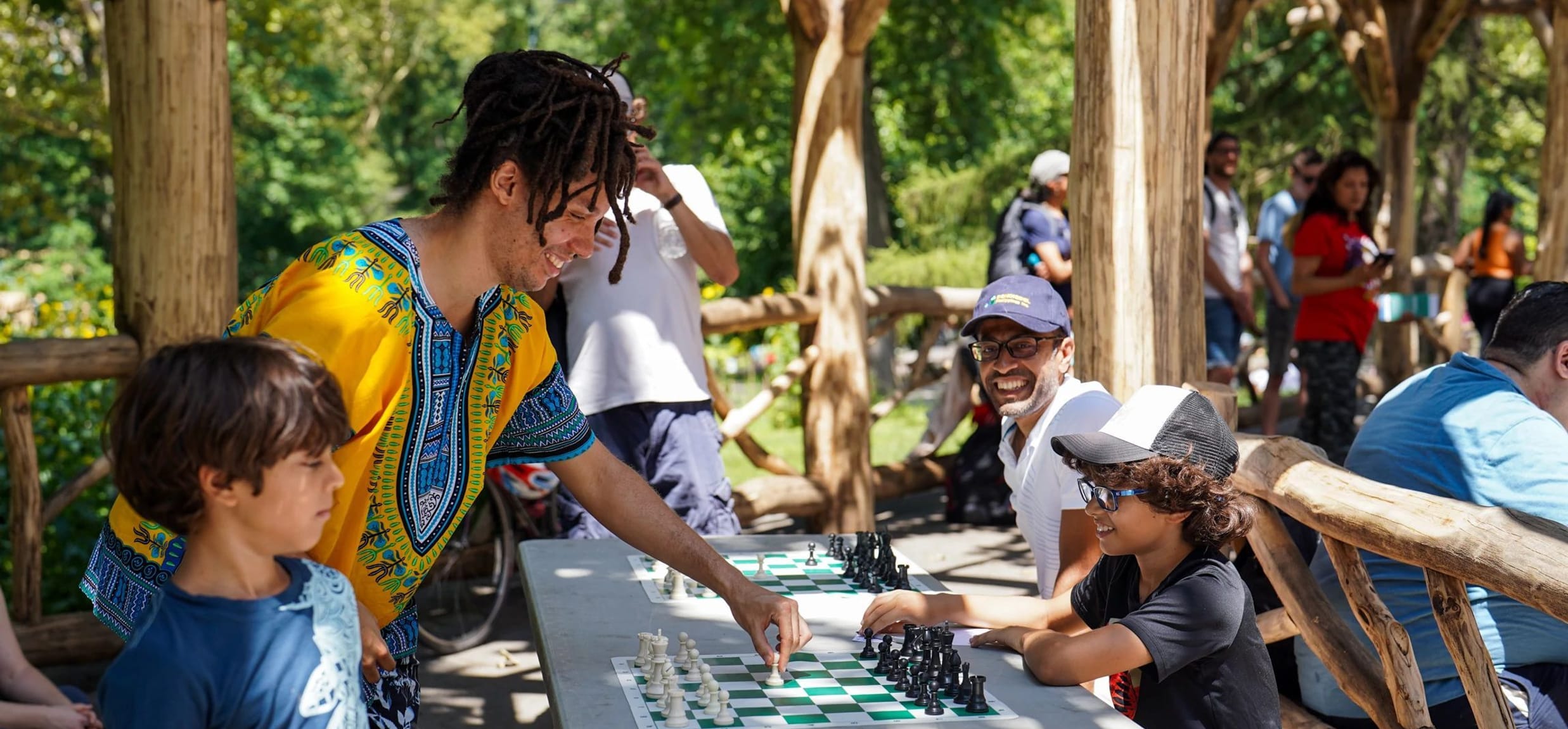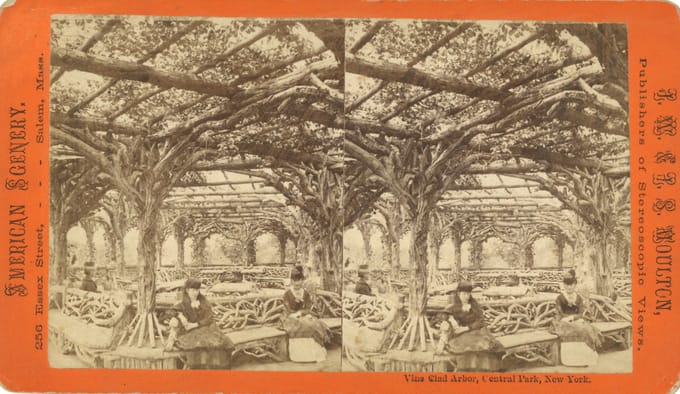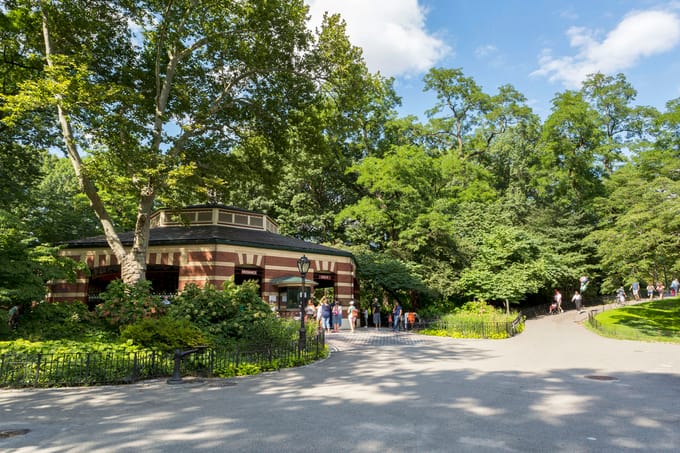Magazine
5 Questions with International Chess Master Kassa Korley

Chess is one of the most popular games around the world and a familiar sight in New York City parks. Central Park is no exception: The newly restored Chess & Checkers House in the historic Children’s District is a picturesque spot for a quick round of checkers or an exciting chess match. Under the building’s open-air pergola, you can spot international visitors relaxing and locals playing a friendly game.
Chess serves as a source of connection and community across nations and generations—a quality that is important to International Master and native New Yorker Kassa Korley. Despite never having a coach or formal instructor, Kassa took the chess world by storm. At the age of 15, he became the youngest African-American to achieve the title of National Master. Over the years, he has continued to refine his game while sharing his unique chess philosophy.
We sat down with Kassa in the days before he joined the Central Park Conservancy for an iteration of our Chess Lecture and Simul Series at Chess & Checkers House, where he enjoyed playing in his youth.

Kassa Korley gives a chess lecture and simul at the newly renovated Chess & Checkers House on July 22, 2023.
When did you start playing chess? What attracted you to it?
I don't know how I learned how to play chess, but I started when I was five. I grew up in New York City—in Harlem, specifically. Where I got off the school bus, there was a guy that sold flowers named Sonny. And Sonny also happened to have some chess tables and chess sets. So, in between his flower sales, I would play him in chess, and he would crush me and talk trash while he was doing it. I kept coming back day after day. By the time I was eight or nine, I was winning most of the games, and that was kind of my first real, consistent foray into chess. It was someone that was an adversary, a friendly adversary, that I could play and practice against.
Can you describe a special memory or highlight of your chess career so far?
Some of the best moments in my life have been connected to chess.
When I was 15, maybe a bit younger, I became the youngest African-American National Master in history. That record has since been broken several times over. But it was a really massive achievement for me. I didn't know I had broken a record, but it was such a big desire [of mine] to become a master. It was particularly memorable because I'd been close to the number you need, 2200, for some time. I'd been in the 2100 range, and I'd lost rating and seven consecutive tournaments in a row. I made some adjustments to my game, and I got a little introspective. All of a sudden, it just came back. The tournament where I did cross over 2200, I beat several masters. So, it felt really, really good to get there.
The second memory that really stands out is something that I'm most well-known for as a chess player. It’s a tournament where I got my second grandmaster norm [editor’s note: A norm is a high-level of performance in a chess tournament]. I had this really special game during that tournament, which is kind of known as my Mona Lisa. I beat someone who was a former top-30 player in the world, and I beat him in spectacular fashion.
What significance does playing chess in public spaces hold for you personally? How does playing chess in Central Park compare to playing in more traditional locations?
I feel like I'm a part of the last generation of players that developed playing in Central Park. The game has gone so much online, and it's been a dramatic shift. As a consequence, the in-person interactions have largely been limited to tournaments. So, playing in the Park—in a leisurely setting—is really, really special. It's maybe a bit nostalgic, but I think it takes us back to the richest form of the game: that it's deeply personal and emotional. You're invested, and there's an exchange of ideas and thoughts. There's something meaningful about having a presence across from you. Those things matter, and I still get giddy thinking about them.
As a society, we've definitely become way more technologically engaged than ever before. I think folks are yearning for things that can capture their attention. Chess is one of those things that can capture your attention, can inspire creativity, can get folks of different generations—not just ages—engaged with one another. I think those are all things that are lacking, or at least that we need more of, at this time.
[And so] playing chess in Central Park is really special. Of course, you [also] have the scenery, all the green behind you. I've played at Chess & Checkers House many, many times. There's a picture of me there when I'm like eight, playing against Jennifer Shahade—who's one of the best-known women chess players in the US today—in a simul. There's a great legacy of “simul-giving” in the Park, and playing regulars in the Park, too. So I've frequented Central Park to play chess dozens of times over the course of my life.

As a native New Yorker, Kassa Korley enjoyed playing matches and attending simuls at Chess & Checkers House in his youth.
What are some misconceptions the public has around the game of chess?
I think the biggest misconception that the public has about chess is that you have to be a certain type of person or have a particular set of skills to be successful. Typically, I hear, “Oh, I'm not good at thinking a lot of moves ahead.” Or, “I'm not a math or science type of person.” Well, guess what? Neither am I. I was someone who was not very good at science. I mean, that's an understatement. I was very bad at science growing up. And once math went away from numbers and became letters, I wasn't good at that either. What I was great at was reading and writing.
I think there are two types of chess players: There's the math or science type, and then there's the chess philosopher. The chess philosopher has a particular ideology, philosophy, play style, or dogma that they try to play every game. Mine is war of attrition. I believe if you create a little weakness here, you create a little weakness somewhere else, then the edifice will collapse over time. I try to stick to that strategy—stick to my strengths—as much as possible. So, really, chess is about you. Chess is about playing to your strengths and using what you know—what's informed by your life perspective—and trying to put that on the board.
How does chess bring people together?
On one level, you could say chess is this one-on-one game, and it's not very social at all. But on the flip side, when you go to chess tournaments, you find dozens and dozens of people—sometimes hundreds of people—all sitting across from each other playing this board game. And it's very rare that you have folks from all walks of life and intergenerationally having this exchange. You can have eight- and nine-year-olds competing with 40- and 50-year-olds, and they're having this silent conversation.
Chess creates a community. Especially when you're just starting to get into the game. There are a lot of other people that are passionate about it, seeking it out, wanting to play opponents. You can very easily build a community of like-minded enthusiasts. Adults are getting into chess because of the Queen's Gambit or other [media] lately, and there are chess clubs popping up all around the City and the world. I think it creates connectivity, especially when it's in a more casual setting.
Hannah Payne is the Assistant Manager of Content at the Central Park Conservancy.



